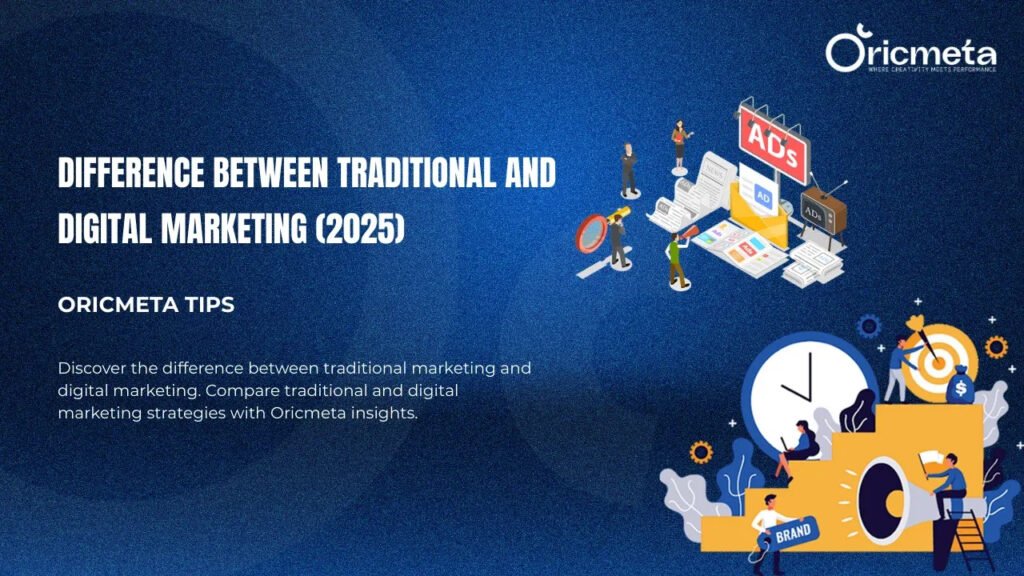Difference Between Traditional and Digital Marketing | Oricmeta
Introduction
Have you ever wondered why some businesses still invest in billboards while others focus only on Instagram ads? That’s because both traditional and digital marketing play crucial roles in reaching customers. While traditional marketing uses methods like TV, newspapers, and radio, digital marketing relies on the internet, social media, and search engines.
In this blog, we’ll explore the difference between traditional and digital marketing in detail, using simple language and real-life examples. Think of it like comparing letters sent by post with emails—both can deliver a message, but the speed, cost, and reach are worlds apart.
Discover the difference between traditional and digital marketing. Learn how digital marketing and traditional marketing compare in today’s business world.
What is Traditional Marketing?
Traditional marketing refers to the age-old ways of promoting products and services through offline channels. These include TV commercials, radio ads, print media (newspapers and magazines), direct mail, brochures, and billboards.
It’s the marketing style our parents and grandparents grew up with. You might remember catchy jingles on TV or brightly lit hoardings on highways—that’s traditional marketing in action.
What is Digital Marketing?
Digital marketing, on the other hand, happens online. It involves social media, search engines, email marketing, websites, and online ads. Unlike traditional methods, it allows businesses to connect with customers in real time and even personalize messages.
For example, when you see an ad on Instagram for the very product you Googled yesterday—that’s digital marketing at work.
The Core Difference Between Traditional and Digital Marketing
The difference between traditional and digital marketing lies mainly in the platform, interaction, and measurability.
- Traditional marketing is one-way communication: businesses speak, and customers listen.
- Digital marketing is two-way: businesses talk, customers respond instantly.
Think of traditional marketing as a stage performance (audience claps but can’t talk back) and digital marketing as a conversation at a café (both sides interact).
Channels Used in Traditional Marketing
Some of the most common traditional marketing channels include:
- Television commercials – broad reach, expensive.
- Radio ads – cost-effective, local audience.
- Newspapers and magazines – trusted sources, great for branding.
- Billboards and posters – high visibility, location-based.
- Direct mail and flyers – personal touch, tangible impact.
Channels Used in Digital Marketing
Digital marketing offers a wide range of platforms, including:
- Social media marketing – Facebook, Instagram, Twitter, LinkedIn.
- Search engine optimization (SEO) – ranking websites on Google.
- Pay-per-click ads (PPC) – quick visibility with paid campaigns.
- Email marketing – direct connection with customers’ inbox.
- Content marketing – blogs, videos, infographics.
Audience Reach and Engagement
- Traditional marketing generally has a local or regional reach.
- Digital marketing has a global reach, breaking barriers of geography.
For instance, a newspaper ad in Delhi will reach only local readers, but a YouTube ad can be seen worldwide.
Cost Comparison: Traditional vs Digital
- Traditional methods like TV ads can cost lakhs of rupees for just a few seconds.
- Digital campaigns can start with just a few hundred rupees and reach thousands online.
This makes digital marketing more budget-friendly, especially for startups.
Measuring Results and Analytics
- With traditional marketing, it’s hard to track exact results. You don’t know how many people saw your billboard.
- With digital marketing, you can measure everything—clicks, shares, impressions, conversions—using tools like Google Analytics.
Flexibility and Adaptability
Once you’ve printed a newspaper ad, you can’t change it. But digital ads can be edited or stopped within minutes. This flexibility makes digital marketing highly adaptable.
Customer Interaction and Feedback
Traditional marketing is mostly one-sided. Customers see the ad but can’t immediately respond. Digital marketing encourages feedback through likes, comments, reviews, and messages.
Longevity and Impact
- Traditional marketing materials like magazines or billboards often last longer.
- Digital campaigns are shorter but can go viral and gain massive attention quickly.
Which Works Better for Small Businesses?
Small businesses benefit more from digital marketing because it’s affordable, measurable, and targeted. However, using a mix of both can maximize visibility.
Examples of Traditional Marketing in Action
- Coca-Cola’s billboard campaigns.
- TV ads during cricket matches.
- Flyers distributed in local markets.
Examples of Digital Marketing in Action
- Amazon’s personalized email campaigns.
- Instagram influencer promotions for fashion brands.
- SEO blogs that attract global traffic.
Future of Marketing: A Blend of Both
The future isn’t about choosing one over the other but combining both. For example, a brand may use billboards for brand awareness and digital ads for engagement. This hybrid approach ensures wider reach and better results.
Conclusion
To sum up, the difference between traditional and digital marketing comes down to reach, cost, flexibility, and interactivity. Traditional methods still hold charm for credibility and local branding, but digital marketing has taken the lead in today’s fast-paced world.
Businesses, big or small, should ideally use a mix of traditional and digital marketing to maximize success.
FAQs
- What is the main difference between traditional and digital marketing?
Traditional marketing uses offline channels like TV and newspapers, while digital marketing uses online platforms like social media and search engines. - Is digital marketing cheaper than traditional marketing?
Yes, digital marketing is more cost-effective and offers better ROI compared to traditional marketing. - Which is more effective: traditional or digital marketing?
Digital marketing is generally more effective because of its global reach, analytics, and interactive features. - Can small businesses use traditional marketing?
Yes, but small businesses usually benefit more from digital marketing due to its affordability and targeted approach. - Will traditional marketing disappear in the future?
No, traditional marketing will still exist, but digital marketing will dominate. A balanced mix of both will continue to thrive.







